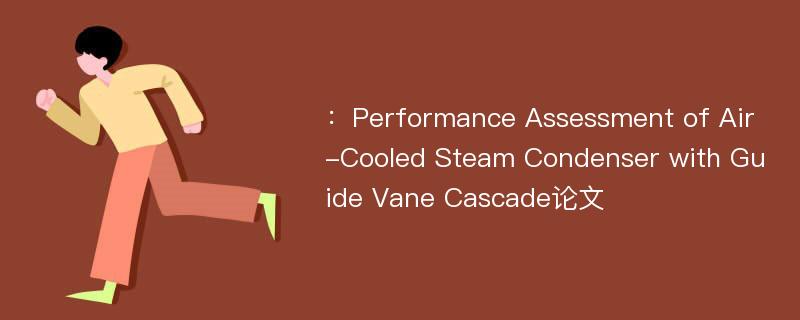
本文主要研究内容
作者(2019)在《Performance Assessment of Air-Cooled Steam Condenser with Guide Vane Cascade》一文中研究指出:Ambient wind has an unfavourable impact on air-cooled steam condenser(ACSC) performance. A new measure to improve ACSC performance is proposed by setting a diffusion type guide vane cascade beneath the ACSC platform. The numerical models are developed to illustrate the effects of diffusion type guide vane cascade on ACSC performance. The simulation results show that this vane cascade can cause the increases in coolant flows across almost all fans due to its diffusion function and lower flow resistance. Meanwhile, the guide vane cascade also decreases the fan inlet temperatures because of the uniform flow field around the condenser cells. Comparing with the case without guide device, the overall heat transfer efficiency is increased by 11.2% for guide vane cascade case under the condition of 9 m/s. The heat transfer efficiency firstly enhances and then decreases with decreasing stagger angle of guide vane under a certain wind speed. The optimum stagger angle corresponding to the maximum heat transfer efficiency is about 65.5°. The heat transfer efficiency always enhances as increasing vane cascade height, and a vane cascade with 20 m to 30 m height may be suitable to the ACSC as considering the cost.
Abstract
Ambient wind has an unfavourable impact on air-cooled steam condenser(ACSC) performance. A new measure to improve ACSC performance is proposed by setting a diffusion type guide vane cascade beneath the ACSC platform. The numerical models are developed to illustrate the effects of diffusion type guide vane cascade on ACSC performance. The simulation results show that this vane cascade can cause the increases in coolant flows across almost all fans due to its diffusion function and lower flow resistance. Meanwhile, the guide vane cascade also decreases the fan inlet temperatures because of the uniform flow field around the condenser cells. Comparing with the case without guide device, the overall heat transfer efficiency is increased by 11.2% for guide vane cascade case under the condition of 9 m/s. The heat transfer efficiency firstly enhances and then decreases with decreasing stagger angle of guide vane under a certain wind speed. The optimum stagger angle corresponding to the maximum heat transfer efficiency is about 65.5°. The heat transfer efficiency always enhances as increasing vane cascade height, and a vane cascade with 20 m to 30 m height may be suitable to the ACSC as considering the cost.
论文参考文献
论文详细介绍
论文作者分别是来自Journal of Thermal Science的,发表于刊物Journal of Thermal Science2019年05期论文,是一篇关于,Journal of Thermal Science2019年05期论文的文章。本文可供学术参考使用,各位学者可以免费参考阅读下载,文章观点不代表本站观点,资料来自Journal of Thermal Science2019年05期论文网站,若本站收录的文献无意侵犯了您的著作版权,请联系我们删除。
